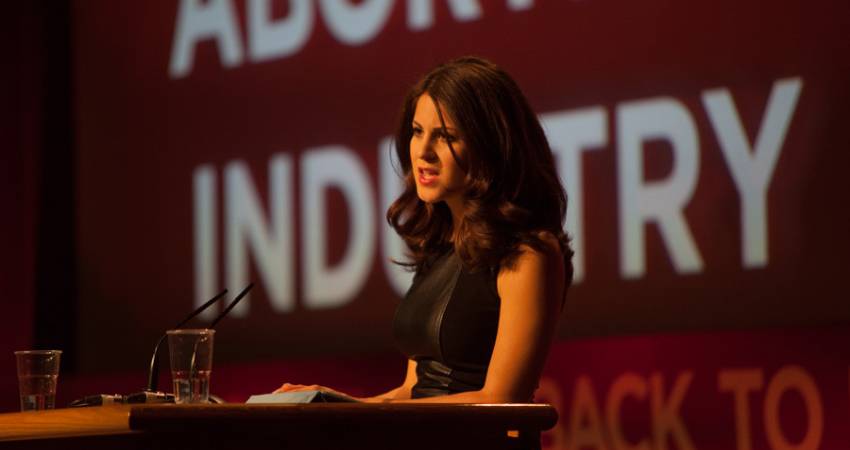
Review: Lila Rosa and The Fight for Life
Lila Rose tells her story, taking on the abortion industry one life at a time, in a new memoir: Fighting for Life: Becoming a Force for Change in a Wounded World.
Lila Rose was 15 when she started the pro-life organization Live Action in her parents’ California home. She was an 18-year-old freshman at UCLA when she did her first major undercover investigation into the abortion industry; 19 when Live Action earned non-profit status; 21 when she gave her first Congressional briefing; and 22 when she raised her first million dollars. At 23, she hosted her first Congressional press conference. At 32, Rose runs one of America’s largest pro-life groups, a global digital leader in pro-life education boasting 1.3 billion video views. All of that is to say that her new book, Fighting for Life: Becoming a Force for Change in a Wounded World, is worth reading.
I’ve read most memoirs written by pro-life activists, and Rose’s book is unique. She shares her struggles with depression, eating disorders, self-harm, and suicidal ideation; reveals how difficult it was to date as a Millennial pro-life leader in the D.C. bubble; and discusses the unwanted romantic attention and even stalking that accompanied her growing national profile. She talks about the crises of mental illness endured by her family, her embarrassing mistakes as a leader struggling to adapt in Washington, D.C., and the difficulties of growing a staff and managing an organization as someone younger than many of those who worked for her. Fighting for Life is a fusion of genres: biography, motivational, and perhaps even a bit of self-help for aspiring activists.
When I asked Rose why she decided to share so much, she told me that some of her friends had asked her the same thing when they read the first draft, but that she wanted the book to be useful for people. She certainly accomplished that—and it is a fascinating story to boot.
Rose’s journey into the pro-life movement resembles that of many other leaders. As a child, she found a copy of Dr. and Mrs. J.C. Wilke’s 1971 Handbook on Abortion on her parents’ shelf and opened it. “I was staring at the photo of a tiny baby with tiny arms and legs severed from a tiny body.” She was stunned to discover the carnage was legal. She began hunting for more information and found a National Right to Life newsletter (her parents were subscribers) that included diagrams of a partial-birth abortion. The images broke her heart and spurred her to action. She volunteered with her grandmother at the local crisis pregnancy center; she prayed outside a San Jose abortion clinic; she fundraised for an ultrasound machine. At the age of 15, she started Live Action because there was no other pro-life group in the San Francisco Bay Area focusing on youth education.
Live Action began hosting presentations, and when Rose headed off to UCLA—chosen because its student body of 40,000 would be fertile ground for her pro-life mission—the group became Live Action UCLA. Rose was doing the usual pro-life things—running meetings, bringing in speakers, and writing for the campus paper—when she attended a workshop put on by the Leadership Institute (LI) and met investigative filmmaker James O’Keefe. She told him she was looking for ideas, and O’Keefe suggested they investigate UCLA’s health center. The two posed as a pregnant student and her friend and asked the nurse what options were available. The nurse discouraged adoption and encouraged abortion. With a $1,000 grant from LI, she launched a magazine called the Advocate, and published the story under the title “Where Have All the Pregnant Women Gone?”
The story triggered a conversation on campus, and Rose began to research the history and tactics of undercover journalism. She connected with Texas activist Mark Crutcher of Life Dynamics, who had hired a young woman in 2000 to pose as a thirteen-year-old girl and call over 800 Planned Parenthood clinics across the country. Each one was happy to give the investigator an abortion or a referral. Rose and O’Keefe decided to replicate the sting at a Planned Parenthood in Santa Monica, with Rose posing as a fifteen-year-old impregnated by a twenty-three-year-old. In California, the law requires healthcare workers to reported suspected sexual abuse of minors. Instead, the Planned Parenthood counselor advised her to say she was 16. “Figure out a birthday that works,” the counselor told her, “and I don’t know anything.” The two repeated the sting the following day at a clinic in L.A. and uploaded the video to YouTube. Overnight, it accrued 20,000 views. Planned Parenthood’s L.A. CEO emailed her, threatening her with thousands in fines. She remembers staring at her screen, realizing the power of independent journalism: A billion-dollar corporation was scared of her videos.
From there, Live Action took off. Rose began to fundraise and planned a cross-country trip to investigate clinics during her summer break. She bleached her hair and got glasses to avoid recognition—by then Planned Parenthood clinics were hanging up her photo. She practiced speaking like a young girl and bought disguises. She and her friends studied the clinics meticulously; practiced their lines; worked on concealing the cameras, sewing them into clothes and purses; charged the batteries. At clinic after clinic, Planned Parenthood staffers were happy to sell an abortion to someone presenting as a minor. The abortion industry issued denials; the mainstream media, in many cases, covered for them, insisting that the videos were “deceptively edited” rather than addressing what the footage actually depicted.
Over the next several years, Live Action would send investigators fanning out across the United States, exposing the corruption, lies, and carnage of the abortion industry. Investigators caught staff lying about fetal development and found them willing to aid and abet sex traffickers—one New Jersey staffer even advised an investigator posing as a pimp that the girls should avoid intercourse for two weeks after the abortions, but that he could always use their bodies “waist up.” In Virginia, a Planned Parenthood staffer offered advice on how to get around parental consent laws. Planned Parenthood reeled and denied, and fired the worst offenders. A dozen states defunded them anyway. In 2015, the House of Representatives voted to defund Planned Parenthood, and Live Action opened a D.C. office to pursue the goal of making defunding a reality.
Along with investigators, Rose recruited a team capable of fundraising, video production, grassroots activation, social media outreach, and writing. Her idealism soon butted up against the cautiousness and apathy of many D.C. insiders, but annual investigations on sex-selective abortion and even infanticide fueled the conversation. She became a pro-life celebrity, flying across the country and around the world, and writes about the profound loneliness she often felt, struggling to find friendships with people her own age outside the D.C. pro-life and conservative bubble. Understandably, she grappled with anxiety. The details Rose provides in Fighting for Life are profoundly humanizing, and I suspect that many outside the pro-life movement would find her memoir worthwhile for precisely that reason.
One of the most interesting chapters is titled “Learn to Pivot,” in which Rose explains why Live Action expanded its operations from lobbying and undercover work into the culture-changing digital activism and videos they focus much of their energy on now. When David Daleiden—who worked on many investigations with Live Action—broke the news that the abortion industry was dealing in baby body parts in 2015, his exposé sent shockwaves throughout the political establishment, with even Hillary Clinton calling the videos “disturbing” in an unscripted moment. It seemed, for a moment, as if the abortion giant might be teetering. But then California attorney general Kamala Harris went after Daleiden, Planned Parenthood’s legal army sprang into action, and a storm of smoke and mirrors initiated the coverup. Watching the abortion industry absorb that body blow and retain federal funding, Rose writes, made her realize that a focus on culture was also essential.
Rose has since gotten married, had a son, and moved back to Los Angeles, where she continues to serve as president of Live Action (which still maintains a D.C. office.) In a conversation earlier this week, she told me that if Big Tech works to shut down Live Action’s digital activism, they will simply pivot once again. Ending abortion, she says, is the cause that defines her life, and there is nothing the industry, the politicians, or the press can do or say to halt this work. Fighting for Life is the story of the passion that fuels not only Lila Rose, but generations of activists who have saved innumerable lives. Her story is that of what one young woman accomplished when she accepted the burden of fighting an extraordinarily cruel injustice. It will leave you wondering what you might do, too.
Featured
- Campaign to stop EU funding out of state abortions - tell your EU commissioner to vote NO
- Judge recuses himself from case of woman praying in censorship zones for “apparent bias”
- I’m a Celebrity star criticises “sad” UK law that aborts babies with Down Syndrome up to birth
- British actress speaks out on “serious risk” assisted suicide bill has for those with eating disorders
- Caplan’s “Tragic Hysteria of Abortion” discusses the flaws with mainstream Turnaway Study interpretations
- Backlash as Scotland report proposes legalising sex-selective abortion up to birth
- Canada hits new record as 1 in 20 deaths a result of Euthanasia
- Ben Scallan defends pro-life on TV show Dinner with the Enemy
- Influencers share the loss of their beloved unborn baby
- Dublin woman with cancer says unborn child was sent to save her
- Mother and baby doing well after surgery for mother’s cancer during pregnancy
- Josiah: Abortion Survivor
- Loving the Unborn
- Rally for Life 2025
- Don't assist Suicide 2024


























